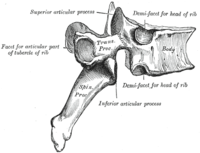
Photo from wikipedia
STUDY DESIGN A retrospective observational study. OBJECTIVE To clarify the association of the paraspinal muscle area and composition with clinical features in patients with cervical ossification of the posterior longitudinal… Click to show full abstract
STUDY DESIGN A retrospective observational study. OBJECTIVE To clarify the association of the paraspinal muscle area and composition with clinical features in patients with cervical ossification of the posterior longitudinal ligament (OPLL). METHODS Consecutive patients with cervical OPLL who underwent cervical magnetic resonance imaging (MRI) before surgery were reviewed. The cross-sectional area (CSA) and fatty infiltration ratio (FI%) of deep posterior cervical paraspinal muscles (multifidus [MF] and semispinalis cervicis [SCer]) were examined. We assessed the association of paraspinal muscle measurements with the clinical characteristics and clinical outcomes, such as Neck Disability Index (NDI) score. Moreover, we divided the patients into 2 groups according to the extent of the ossified lesion (segmental and localized [OPLL-SL] and continuous and mixed [OPLL-CM] groups) and compared these variables between the 2 groups. RESULTS 49 patients with cervical OPLL were enrolled in this study. The FI% of the paraspinal muscles was significantly associated with the number of vertebrae (ρ = 0.283, p = 0.049) or maximum occupancy ratio of OPLL (ρ = 0.397, p = 0.005). The comparative study results indicated that the NDI score was significantly worse (OPLL-SL, 22.9 ± 13.7 vs. OPLL-CM, 34.4 ± 13.7) and FI% of SCer higher (OPLL-SL, 9.1 ± 1.7% vs. OPLL-CM, 11.1 ± 3.7%) in the OPLL-CM group than those in the OPLL-SL group. CONCLUSIONS Our results suggest that OPLL severity may be associated with fatty infiltration of deep posterior cervical paraspinal muscles, which could affect neck disability in patients with cervical OPLL.
Journal Title: Global spine journal
Year Published: 2021
Link to full text (if available)
Share on Social Media: Sign Up to like & get
recommendations!